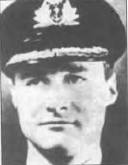- Author
- A.N. Other and NHSA Webmaster
- Subjects
- WWII operations, History - WW2
- Tags
-
- RAN Ships
- None noted.
- Publication
- September 1998 edition of the Naval Historical Review (all rights reserved)

1942, and the British were clinging on while their convoys were only just getting enough supplies through to keep the people and the war effort going. But on the Biscay Coast of occupied France was the strategic port of St. Nazaire, with not only its fleet of submarines, but also the largest dry dock in the world able to accommodate the huge German battleship “Tirpitz”. Her effect combined with the U Boats in the Atlantic could well be fatal to allied convoys.
However, the port seemed impregnable as high level bombing involved the town and French civilians and in 1942, the RAF had no bombs capable of destroying the steel caissons in the dock, each was 50 metre long, 17 metres high and 11 metres thick. Coastal artillery, anti-aircraft batteries, a huge garrison as well as “E Boats” made sure that this was no easy target.
So many commandos were needed to carry out the demolition work that a large ship was needed. Enter the old destroyer “Campbelltown” but she also had an additional and suicidal purpose. Crammed into her bow, 24 depth charges as well as 4 tonnes of high explosive. Now she would ram the huge gates, be scuttled and blow up everything after an 8 hour delay was set on the TNT. The 80 commandos on her would deal with secondary targets assisted by other troops in 16 armoured patrol launches and a gunboat. They were also to capture the southern lock lifting bridge so there would be an escape route to the waiting launches. Thus “Operation Chariot” was put into action on 27th March, 1942.

March 1942 and were completed in 15 days.
All went smoothly for the raiders until they were 2kms from the docks when a searchlight stabbed out and a warning burst of 20mm gunfire, but a four minute reprieve was earned by a quick thinking signalman who flashed back a message that they were making to St. Nazaire according to orders. But a recognition signal in the wrong colour soon gave the game away and all hell soon broke loose.
At 0128, the shore batteries opened up and “Campbelltown” suffered a withering barrage. Shells tore her hull. A 12 pounder was destroyed as were the mortars and their crews. Many commandos on the deck were also cut down without firing a shot. After the initial fusillade, the British gunners pounded back at the enemy and within several minutes the German heavy guns were quiet. In the glare of searchlights, “Campbelltown” steamed in at 20 knots and was being riddled with tracer fire as she tore through the anti-torpedo nets and at 0134 smashed into the caisson doors to the lock. German resistance was ferocious now with 40 of the 80 commandos in “Campbelltown” killed and of all the rest of the raiders aboard the launches, only 40% managed to get ashore and fight virtually hand to hand to achieve their targets. Many succeeded, but at a fearful cost.
Several groups attacked ships that were moored, throwing satchel charges down hatches and putting high explosives into the boiler rooms of several minesweepers. Lieutenant Sturt Chant led a group to the docks pumping house and machinery and after blowing a steel door, charged down 40 feet of stairs and laid H.E. charges which turned it into a pile of debris and twisted metal.
The winding house of the dock was also wrecked and at the inner caisson, twelve 8 kg charges were suspended over the side, then blown up, with water flooding through the damaged gate into the dock. What was left of the landing parties made their way to the old entrance but the launches to take them off had been destroyed, wreckage and floating bodies littered the water everywhere.

HMS Campbelltown wedged fast in the dock gates after her valiant attack. In her bows are 24 depth-charges and 4 tons of TNT all of which exploded two days later, when her decks were crowded with German naval and military personnel.
The next day, as some 300 German men and Officers were checking damage and aboard “Campbelltown”, its charges blew up completely destroying the gates as well as the unfortunate ones on or near her. The dock was never to be used by the Tirpitz or any other heavy German cruisers.
For the Allies, the raid claimed a fearful casualty cost. Of the naval personnel, 34 Officers and 157 ratings were killed, 59 commandos were killed with a further 109 taken prisoner. The same number, 109 made it back home out of a force of 468 that set out and did achieve its goal in one of the greatest raids of WWII.




